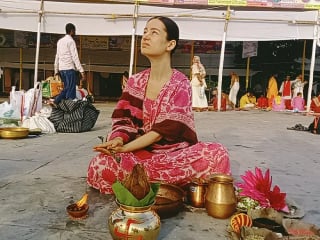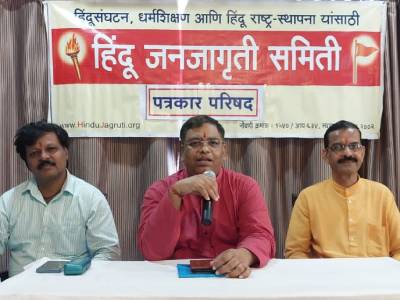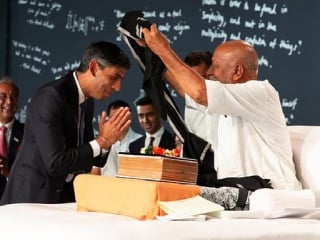The Times Group believes in touching the lives of every individual. Its latest publication: The Holy Sankara Mutt is a coffee table book that is a collector’s issue for those spiritually connected to the Kamakoti Peetham in Kanchipuram, Tamil Nadu. S Meera reports.
India has a strong spiritual foundation. Its Vedas and Upanishads have stood the test of time. The Bhagavad Gita is a guiding force that shapes the life of many – be it those who are spiritual or those who believe in doing their duty, honestly and with dedication.
It is a land of a million Gods, but believes in One God – the ultimate. To understand that One, attain salvation and merge with the Paramatma, the supreme life force, the jeevatma or the human soul needs guidance. Therefore, the Guru as the spiritual guide is given a special role and a place in the Indian way of life.
Even in this age of industrialization and globalization, the link with the Guru has remained intact, guiding people through their lives, leaving them anchored in their values, cultures and traditions.
One of the longest established line of Gurus is that established by Adi Sankara.
ADI SANKARA
The Advaita philosophy, propounded by Adi Sankara, has a strong hold on the thinking of the current day philosophers. Believing the world to be but an illusion, the Gurus in this tradition preach the importance of understanding the supreme soul, overcoming the blindness that keeps us bound to worldly matters, and merging with the Supreme.
Adi Sankara himself was a great philosopher, a child prodigy who had mastered the Vedas at the age of eight, was an expert in all branches of knowledge by twelve and had written commentaries on Vedanta by the age of sixteen. In his short life of thirty-two years, he had propounded the Advaita philosophy.
This philosophy won him many followers, and has also been considered responsible for the revival of Hinduism in that period.
He is believed to have been born to a Kerala Namboodri couple by the Grace of God in Kalati. Shivaguru and Aryamba though devout and well-to-do, were childless. Finally, they went to Thrissur and prayed to the presiding deity there. Pleased with their devotion, God offered them a choice of one son who may be short lived, but will be a great teacher, or many dullwitted children. The couple opted for the former, and they were blessed with Sankara.
When he was sixteen, it is believed that a crocodile caught his leg while he was bathing in the river and released him only when his mother promised to allow him to become a sanyasi. Thus began Sankara’s journey into the world of spiritual knowledge.
After much traveling and exchange of ideas with several leading gurus of the day, Sankaracharya is said to have established four spiritual centres in the four corners of the country – Sringeri, Dwaraka, Puri and Uttarakhand.
It is believed that the Sri Kanchi Kamakoti Peetham was established by Sri Adi Sankara in the year 482 B.C. He retired to Kanchi, the Southern Mokshapuri, towards the end of his earthly career and shook off his mortal coils in that sacred city. He initiated a very young boy into the ascetic order, nominated him as his successor in his Kanchi Mutta, and placed him under the care of Sri Suresvara, the most aged and the most erudite of His disciples.
Sri Sankara Bhagavatpada attained Videha mukti in his 32nd year – Cyclic year Raktakshi, Adhika Rishabha Maasa, Sukla Ekadasi – Kali 2625 (477 B.C.). Over the years, Kanchi has experienced an unbroken line of 70 Acharyas (spiritual leaders).
REESTABLISHING DHARMA
One of the prime roles the Acharyas or the Gurus of the Mutt have taken is in the protection of Veda Dharma, for propagating the Advaita discipline, and alleviating the sufferings of the people.
With this end in mind, they have initiated several activities and institutions over the years. Renovation of ancient temples that are in need of repairs is one of the important activities of the Mutt. New temples have been erected where needed.
While activities of a religious nature are undoubtedly within the realm of the Peetham, the social side has not been neglected.
EDUCATION
A good number of Veda Patasalas have been established wherein different sakhas of Vedas are being taught.
Apart from Veda Patasalas, seventeen Oriental schools and thirty-eight Sankara Schools are functioning in different parts of the country under the guidance of the Mutt.
Sri Pratyaksha Trust, established with the Acharyas’ blessings, aims to help revive old traditional and cultural values. It also helps young vedic scholars in remote parts of the country, in addition to provide educational assistance to the poor and the needy in the villages. It also provides medical assistance to the villagers by organizing medical camps.
HOSPITALS
Sri Kanchi Kamakoti Peetham runs hospitals at different places, which includes the Kamakoti Child Trust Hospital at Chennai, Eye Hospitals at Coimbatore and Guwahati, hospitals at Madhubani (Bihar), Rathura for tribals (Uttranchal), Berhampur (Orissa) Hindu Mission Hospitals in many places in Tamil Nadu.
Sri Sankara Heart Foundation has been established with the blessings of the Acharyas to cater to the needs of research in the medical field, especially in heart disease. It also provides help to the poor and the socially and economically backward communities in undergoing treatment for heart diseases. It also spreads awareness about the causes of heart diseases and possible preventive measures.
SOCIAL CAUSES
The Acharyas’ sympathy for the poor and the lower classes of society is also well known.
Charitable trusts, established with the blessings of the Acharyas, come to the aid of poor families to enable them to perform marriages of their daughters, homes for the aged and destitutes are functioning with a considerable number of inmates in each. Also, at Kalavai (Tamil Nadu), a home for the disabled has been set up. Handicapped persons are provided with tricycles, artificial limbs, etc.
Sri Chandrasekharendra Saraswati Rural Development Trust and several such other organisations take care of the rural and neglected areas. Unemployed youths are provided with means for starting some craft to earn their livelihood. Likewise, women are given sewing machines to become self-employed.
Nithya Annadhanam (free food) is provided to all devotees visiting Kanchi and the Mutt. The "Pidi Arisi Thittam" (Handful of Rice) scheme is running successfully at many places. Under this scheme, every household sets apart just a handful of rice every day, which is collected by a central agency once a week, cooked in some temples, offered as neivedya to the deity and then distributed to the poor and needy.
Prasadam, blessed by the Acharyas, are distributed to the patients in hospitals, inmates of jails, orphanages, etc.
The Mutt runs go-salas (shelter for the cows).
Victims of flood, famine, earthquake and other natural calamities are being helped in various ways under the orders of the Acharyas.
THE HOLY CITY OF KANCHI
Nagareshu Kanchi – the king among cities is Kanchi, so sang poet Kalidasa. Historical, spiritual and beautiful – Kanchipuram is all that and more. It is known for its temples, has the Kanchi Mutt that has millions of followers across the globe, several rulers that have enriched the city and its silk that has caught the imagination of several generations. It has been referred to in several leading literary, scholarly and spiritual works, has been associated with several leading religious preceptors such as Adi Sankara and Sri Ramanujacharya, among others, has been the home of several poets and scholars, was a centre for learning and is considered a place for art.
Kanchipuram is one of the oldest cities in South India, it was a city of learning for both Tamil and Sanskrit, and was believed to be visited by Hsuan Tsang. Kasi and Kanchi are considered the two eyes of Siva, and it is also considered one of the seven mokshapuris – the place for salvation. It is one of the Panchabhuta kshetras – one of the five elements – representing earth.
Kanchipuram is also considered the navel of the earth, and the word Kanchi refers to the girdle enjoining the belt worn by women around their waist.
Located to the north of Chennai in Tamilnadu, Kanchipuram has had the privilege of being the capital city of the kings of the Pallava and the Chola kings and the Rayas of Vijayanagar. The Pallava kings, especially, were keen builders and have been responsible for raising several temples and other monuments of significance. Today, it is the headquarters for Chengalpattu district. The city is well connected through road and air and the nearest airport is in Chennai.
It is one of the seven holy cities of India, and is also called the city of thousand temples. Only 200 of these have survived the ravages of time and highlight the flourishing Pallava art and architecture with the embellishments from the Chola, the Vijayanagara and Chalukyas kings. Of these, 108 are Siva temples and 18 are Vishnu temples.
Mention Kanchipuram, and apart from the temples and the architecture, what immediately comes to one’s mind is the silk. Distinct from the silk from other parts of the country, the Kanchipuram silk has been known for its traditional designs. But now, with changing tastes and times, the designs have also changed to cater to the modern and the young.
A great center of learning during the ancient and medieval times, Saiva Saint Appar is also said to have lived here. Buddhist Stupas bear testimony to the fact that Buddhism spread here. Other Vaishnavite and Saivaite Mutts are also located in the city, adding to its glory and spiritual ambience.
The Holy Sankara Mutt
Cover Price: Rs.450, No. of Pages : 168
Available at:
Kanchi Mutt
Tel: 27233115, 27222115 Mobile: 9443405965 [email protected] www.kamakoti.org
&
Sri Pratyaksha Trust
Mobile : 9962513074 [email protected]
Soon to be available at select premium book stores
THE COFFEE TABLE BOOK The Coffee Table Book was released on September 4, 2009, by the current Guru, Sri Jayendra Saraswathi Swamigal, at the Kanchi Mutt. The book traces the lineage and highlights the greatness of the 70 gurus or Acharyas who have ably guided the Mutt and its followers, keeping them steady on the path of Dharma and navigating through good and bad times to retain the glory of the Mutt. The Coffee Table Book also details the activities of the Mutt – elaborating on their dedication to social causes, providing modern education with traditional values, ensuring good quality healthcare, and reviving the Hindu traditions. There is a snapshot of the life of Adi Sankara in the form of illustrations with captions. The book is a good mix of text and photographs, making it pleasing to read through even while experiencing spiritual upliftment.
The saying goes – mata, pita, Guru, deivam. Blessings from the Guru are like the blessings from the God. He guides you in the path of the truth. The first guru is Lord Krishna, who guided us through the Bhagavad Gita in the Dwapara Yuga. When people were misguided in the Kaliyuga, Adi Sankara showed the way. Without Him, we would still be confused and lost. The Kanchi Kamakoti Peetham, established by him where he installed the Yoga Lingam, is a great Peetham that has been guided over the centuries by great yogis. This Coffee Table Book highlights the greatness of the Peetham, is rich in content and pictures, and aptly concludes with a picture of Adi Sankara worshipping at the feet of Kamakshi Amman. I am on my way to a global tour and the quality of the book is such that I can talk about it wherever I go. His Holiness Sri Jayendra Saraswathi Swamigal
It was Adi Sankara who sowed the seeds of Vedanta for unity. These days, our country is beset by two problems: economic or Aarthik Vikas and the problem of terrorism – Aatank Niraas. Adi Sankara’s teachings can go a long way in finding a solution to these problems by giving us proper guidance. His Holiness Sri Sankara Vijayendra Saraswathi Swamigal
This book is a window to the Kanchi Kamakoti Peetham. Kalavai Sachithananda Swamigal
An uplifting, divine experience, it is an amazing effort by The Times Group. Tracing the Lineage of the Acharyas from 482 B.C to 2009 AD, with pictures, about 2500 years of unbroken tradition and religious institution, it is a rare insight – I think it is the first of this kind in the world for any particular religion, religious institution ever over such a large span of time. Dr. R. Sundaravelu , Chairman and Managing Director , Alchemy Biotech Pvt Ltd
The book on Kanchi Mutt by The Times Group has really captured the greatness of this great institution extremely well. It will be a great knowledge source for all, particularly the younger generation, who will get an exposure to this unique lineage. K. Jayaramakrishnan , Managing Trustee , Sri Pratyaksha Charitable Trust
Today was a great day of spiritual awakening and learning, and it was an honour to be a part of the ceremony. S. Sriharan MD & CEO, Asiana Hotel.
Source: epaper.timesofindia.com
Also See
 |
Dharma Jagruti SabhasDhama Jagruti Sabhas is creating mass awareness among Hindus about various problems affecting Hindu Dharma. |
 |
Save temples from Anti-Hindus
Temples are the centres of Hindu Dharma. Anti Hindu forces like Muslims, Congress, Christians has constantly targetted them. HJS is fighting against these forces. |






